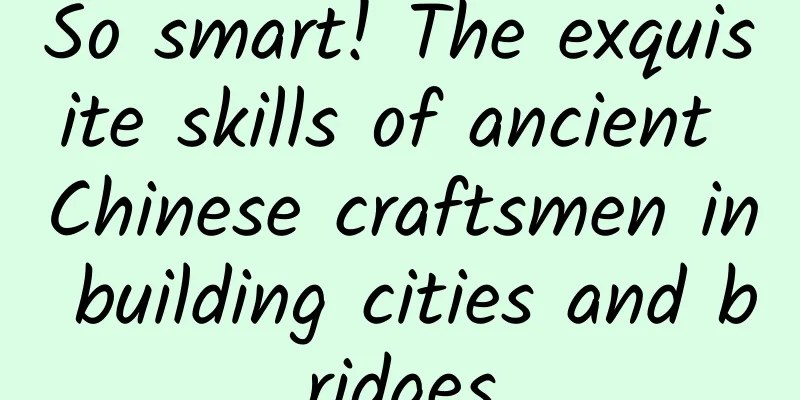So smart! The exquisite skills of ancient Chinese craftsmen in building cities and bridges

|
Primitive humans used wood and straw to build simple houses, which was an important sign of the progress of civilization. Similarly, humans built large-scale, permanent defense projects such as "cities", which was one of the signs of entering the civilized era; bridges were also an important part of the process of expanding human communication and developing transportation. Let’s first talk about the ancient Chinese’s city-building technology. War is an important phenomenon that accompanies human civilization. The ancient Chinese classic Zuo Zhuan says: " The most important affairs of a country are sacrifice and war. " This shows that war was of great significance to the ancients. Here we are talking about "city" in the field of architecture, which refers specifically to the walls around the city , which is a large-scale, permanent defense project, mainly for war defense. Of course, larger cities gradually have the function of protecting people's lives. Archaeological evidence shows that the "Fertile Crescent" in West Asia had human settlements and stone walls about 10,000 years ago. In China, "rammed earth walls" dating back to the early Shang Dynasty, about 3,500 years ago, have been discovered in many places. Some cities have a circumference of 7 miles and are very strong. At this time, there were already wide moats outside the walls (some were 10 meters wide), which were called "chi" in ancient times. The combination of city and pool is called "city pool", which refers specifically to large-scale, defensive buildings. 1. The city-building styles of ancient Chinese continued to improve. In order to enhance the defensive power of the city walls, the ancients constantly improved the style of city construction. During the Spring and Autumn Period and the Warring States Period, parapets and battlements began to be built on the top of the city walls, called dié and pí, ní. The classic book "Mozi" from the Warring States Period said: " Pí is three feet wide and two feet and five inches high " (1 foot is about 20 centimeters). "Mozi" also recorded two other city construction technologies: one is the "hanging gate" controlled by a winch and the "suspension bridge" on the moat; the other is the "gatehouse" above the city gate and the "corner tower" at the corner of the city. The Han Dynasty also saw new developments in the city-building style: first, the outer wall of the city wall was built with a protruding "enemy tower" (horse face) to defend the city wall from the side; second, the "urn city" was built at the city gate, which had multiple functions such as strengthening the city gate protection, stationing troops, and luring the enemy into a "turtle in the urn". These city wall defense technologies were very mature by the Tang Dynasty and continued into the Ming and Qing Dynasties . Of course, the city walls also became taller and stronger. For example, the city gate towers were originally single-story, but in the Ming and Qing Dynasties, two- and three-story city gate towers appeared. In ancient China, cities were divided into large and small. The capital of the country, as well as the cities of prefectures and prefectures, were all large cities, while smaller ones were called passes and forts. Passes were military defense facilities set up at strategic passes or major transportation routes, which were smaller cities and were generally used only for garrisoning troops. Forts were a type of civilian defensive building that appeared in the Han Dynasty. From the Wei and Jin Dynasties to the Southern and Northern Dynasties, forts were everywhere! Fort walls could be used for protection and storage of food supplies, similar to medieval castles in Europe and earthen buildings in Fujian, China. In addition, the term forts also refers to militia organizations for self-defense of clans and groups during wartime! 2. Ancient Chinese people mostly used rammed earth method to build cities. In ancient China, when building large city walls, stones and bricks were rarely used. Instead, similar to building houses, the "rammed earth method" was mostly used. We know that brick-making technology was already very sophisticated during the Qin and Han dynasties. The Mausoleum of the First Qin Emperor had "strip bricks" similar to modern bricks and of good quality. However, ancient Chinese buildings were generally low and supported by wooden columns and beams, without considering the load-bearing problem of the top of the wall. Therefore, until the Ming Dynasty, most houses in China were built on rammed earth foundations, with adobe bricks and fired bricks coexisting. Fired bricks were only used in the lower part of the wall to prevent moisture and alkali. The same is true for city walls . When building a city, the soil is compacted layer by layer, with a width at the bottom and a narrowness at the top, and the height can reach more than ten meters. This way, local materials can be used, and there is no need to transport materials over long distances. It is convenient and easy, but it requires a lot of manpower. Although the lifespan of rammed earth city walls is shorter, they can still be used for decades. Unfortunately, when we modern people cross a thousand years, we can only see some "mud piles"! The Great Wall of Qin Dynasty is a typical example. Ancient Chinese also invented a special building material "Sanhetu" (which appeared at the latest in the Northern and Southern Dynasties) in the application of "rammed earth method" . It is a mixture of lime, broken bricks and fine sand. The proportions are determined according to the sand content of the soil. Reinforcements such as glutinous rice, animal blood, tung oil, plant juice, alum, etc. are also added. Sanhetu is stronger and more water-resistant after being rammed layer by layer. It is mostly used for building foundations and road cushions, especially for ramming out the most solid city walls! Therefore, until the Song Dynasty, China used rammed earth and cemented earth to build cities, and only used fired bricks at the gate piers and corners of the city walls. From the Song Dynasty to the Ming and Qing Dynasties, fired bricks were used more in city construction, but most of them still used rammed earth as the "core" and bricks were built on the outside of the rammed earth wall, or bricks and stones were mixed to strengthen the surface of the city wall (such as the Beijing city wall in the Ming Dynasty). It was not until the Qing Dynasty that small city walls in some county towns were built entirely with bricks. Tips: The most famous story of building a city with rammed earth belongs to the Xiongnu Helian Bobo (381-425), who was the founding emperor of the northern Hu "Xia" during the Southern and Northern Dynasties. He mobilized more than 100,000 civilians to build the capital "Tongwan City" (now northern Shaanxi). In order to make the city impregnable and lasting, he set extremely high construction standards. Legend has it that every time a section of the city wall was built, he asked the sword casting craftsmen to poke the city wall with the newly cast swords. If they poked in, it meant that the city wall was not strong enough, so they killed the civilians who built the city. If they could not poke in, it meant that the swords were not sharp enough, so they killed the sword casting craftsmen. The bodies of the dead were built into the wall and became the reinforcement of the three-in-one soil ! It is said that this is the origin of the term "flesh and blood Great Wall". Sadly, the solid Tongwan City was breached only 9 years after it was built, and the Hu Xia regime only existed for more than 20 years. Such a bloody flesh and blood Great Wall is not worthy of praise! Let’s talk about the ancient Chinese bridge-building technology. Cities and houses are buildings for human settlement, while roads and bridges are buildings for human travel and communication. The hardworking and wise ancient Chinese made great achievements in bridge construction and are world-renowned! We know that, except for the most primitive single-log bridge, the bridges built by humans can be divided into four major systems: floating bridges, beam bridges (bridges with main beams as load-bearing), arch bridges, and cable bridges . The earliest bridge built by humans should be a floating bridge, but it is difficult to see it in archaeological excavations. The oldest existing bridge in the world is an ancient Greek stone bridge about 3,300 years ago, a small bridge made of piled stones. The earliest one in China should be the "floating bridge". The "Book of Songs·Da Ya" says: " To welcome the bride on the Wei River, build boats as bridges ." It is said that King Wen of Zhou used boats to build a floating bridge on the Wei River to welcome the bride. The "Records of the Grand Historian" records that King Zhaoxiang of Qin (257 BC) built a "big floating bridge" on the Yellow River in Puzhou, Shanxi (now Fenglingdu)! During the Sui and Tang Dynasties, boats were also connected here to form a floating bridge. It was called "Pujin Bridge" in the Tang Dynasty. It was sometimes broken and sometimes restored until the Northern Song Dynasty. Archaeological evidence shows that there are four iron bulls and iron men from the Tang Dynasty here, each weighing more than 70 tons, which are the special floating bridge anchors of Pujin Bridge. China's "beam bridges" are widely used. Wooden beam bridges are the most common, but due to the limitation of wood, they are not very large and are difficult to preserve. Famous stone beam bridges include the Ba Bridge in Xi'an, Shaanxi, the Luoyang Bridge in Quanzhou, Fujian, and the Anping Bridge in Jinjiang. According to historical records, the Ba Bridge was first built in the Western Han Dynasty and rebuilt many times. It is based on wooden piles, with stone millstones on top, and then stacked stone pillars (up to 408) and bridge boards on top. This is probably the typical craftsmanship of ancient Chinese stone beam bridges! The two bridges in Fujian were built in the Northern Song Dynasty and the Southern Song Dynasty respectively, and they are already "big stone bridges" with a length of over 800 meters and 2,200 meters. In addition, Han Dynasty tombs liked to depict images on bricks and stones, and there are also many images of bridges at that time. For example, a stone beam bridge was carved in a Han Dynasty tomb in Jinan, Shandong. There are two pillars with brackets under the bridge, beams on the pillars, and then the bridge deck, railings on both sides, and 45-degree inclined surfaces at both ends. It should be a large stone bridge with a large span! There are also images of wooden beam bridges in some Han Dynasty tombs, and the span of the bridge is smaller. China's "arch bridges" have a long history and are world-famous for their technology. Arched wooden bridges appeared in "Along the River During the Qingming Festival", but more were stone arch bridges built with natural stones. The earliest Chinese arch bridges should have appeared in the late Eastern Han Dynasty. In the famous Chinese geographical work "Shui Jing Zhu" written in the Northern Wei Dynasty about 1,500 years ago, it was recorded that there was a stone bridge called "Traveler Bridge" in Luoyang, Henan: " The bottom is round and can pass water. " This is the earliest record of a stone arch bridge in China. China also has the world's earliest, largest and most complete single-arch stone bridge, the famous "Zhaozhou Bridge" (Anji Bridge), built in 605 AD (Sui Dynasty). It was designed and built by craftsman Li Chun, with a main span of 37 meters. It was also the first to create an "open-shoulder arch" structure (two small arches on each shoulder of the large arch to divert floodwaters). This bridge has withstood the test of earthquakes and floods for more than 1,400 years, which is truly a miracle in the history of bridges! In addition, the bridge body is decorated with novel and delicate carvings, showing the bold, vigorous, strict and elegant stone carving style of the Sui Dynasty, and has high artistic value. China's "cable bridge" (suspension bridge) appeared very early, and may have been first created by ancient Chinese ethnic minorities ! The ancients used bamboo, rattan, iron, etc. to make chains to build bridges in the western region where the valleys were deep and the water was fast, and it was impossible to build piers and bridges. It was also recorded in the Chinese Buddhist history book "Luoyang Monastery Record" during the Northern Wei Dynasty about 1,500 years ago that there were iron chain bridges in Xinjiang at that time, while iron chain bridges did not appear in the West until the 16th century. The outstanding representative of bamboo cable bridges in the southwest region is the "Zhu Pu Bridge" at the mouth of the Dujiangyan River in Sichuan. The construction date is unknown (it should be before the Song Dynasty). Now it is a cable bridge rebuilt in the Qing Dynasty with a total length of 340 meters. In short, these cities and bridge buildings are important parts of the glorious Chinese civilization. |
<<: Once extinct in the wild in China, now "reborn" in their homeland! What have they experienced?
>>: What? Natural gas can actually be used for cooling after burning!
Recommend
Why does Baidu insist that you use its App?
In the past month, whenever you use Baidu search ...
4,870 varieties, why does Peru collect so many potatoes?
In two inconspicuous small buildings in the south...
How can live streaming make products popular?
A live broadcast room can generate sales of over ...
How much can you borrow for the first time with Youqianhua? What are the application requirements for Youqianhua?
"Youqianhua" is the original credit ser...
Example analysis: Performance optimization of "Qichu Encyclopedia"
Qiqubaike has undergone a major revision after th...
Tang Jialu: 74-year-old ancient technology enthusiast restores historical "artifacts"
The book "Heavenly Creations" written b...
As a newcomer to the industry, this is the most comprehensive industry learning strategy!
In the field of operations , a major difference b...
Serialize the Intent and pass it like a Uri!!!
[[207121]] 1. Do you really need to create a new ...
How can products get more users to pay? Share 3 tips!
When a product enters the mature stage and has en...
The International Space Station is about to be decommissioned. Where will it go? Will it fall or be recovered?
Although the service life of the International Sp...
Experience of using Xiaotiancai phone watch: Who wants it more, the baby or the parents?
It is said that it is easy to make money from chi...
Why can't your interactive solution pass? Experts from big companies teach you these four methods!
This week, we specially invited Yi Yi, a former s...
World Bicycle Day | Cycling regularly has so many benefits! But...
Today is World Bicycle Day . Cycling is a healthy...
Ocean Figures | Liu Ruiyu: Candlelight illuminates the ocean lighthouse and brightens the way forward
|Liu|Rui|Yu| He is rigorous in science and indiff...
Why do cats and tigers look so similar?
Regarding cats and tigers, many people have proba...









